Menstrual Hygiene Awareness, Practices and Health Implications Among Adolescent Girls in Ukpom Abak, Akwa Ibom State, South-South Nigeria
Johnson Ofonime E1, Ekpin Victory Israel2, Ukpong Dorothy Emem3, Akpan Edwin Boniface3, Obimah Solomon3, Udo Mfoniso Emmanuel3, Bassey Christian Daniel3, Uyoho Pius E3, Akabom Emekem Inemesit3
Abstract
Background: Menstrual hygiene management (MHM) is crucial for the health and well-being of adolescent girls. In many developing countries, including Nigeria, awareness and resources for proper MHM are lacking. This study aimed to assess the awareness, practices and associated menstrual hygiene health problems related to among adolescent girls in Ukpom Abak
Materials and Methods: A cross-sectional study was conducted among 169 adolescent girls. Data were collected using structured questionnaires and analyzed with SPSS version 17.0 using descriptive statistics and Chi-square test to examine the association between menstrual hygiene products and lower urinary tract symptoms. The level of significance was set at 0.05.
Results: The mean age of the respondents was 12 ± 0.95. Alternatively, 12 (standard deviation = 0.95). Most participants were aware of menstruation before menarche (79.9%), with mothers being the primary source of information (42.6%). Sanitary pads were the most recognized (73.4%) and used (67.5%) menstrual hygiene products. Despite this, 57.4% of the respondents used reusable cloths. Some health issues around menstruation were reported, including abnormal vaginal discharge (60.4%), lower abdominal pain (47.3%) and genital itching (36.1%). There was a significant association between the type of menstrual hygiene products used and lower urinary tract symptoms (p<0.0001).
Conclusion: The study highlights the need for improved menstrual health education and access to affordable menstrual hygiene products. Comprehensive interventions are necessary to promote proper menstrual hygiene practices and reduce health risks associated with inadequate menstrual hygiene management.
Keywords: Adolescent, Awareness, Menstrual hygiene practices, South-South Nigeria
Introduction
Adolescence, defined by the United Nations as ages 10-19, is a critical period of transition marked by significant physiological changes, including menstruation in females.1 Menarche, the onset of menstruation, signifies the start of reproductive maturity and typically occurs around 13 years old in Nigerian girls.2,3 The age of menarche can vary globally, influenced by heredity, diet, and overall health.4
Menstrual Hygiene Management (MHM) involves using clean materials to manage menstruation, changing them in privacy, and having access to soap, water, and disposal facilities.5 In many developing countries, including Nigeria, awareness and resources for proper MHM are lacking. Cultural taboos and inadequate facilities further complicate this issue, leading to adverse outcomes such as infections, anaemia, school absenteeism, and social isolation.6
Menstruation is often surrounded by silence and shame, particularly in rural areas, where discussions about menstrual hygiene are considered inappropriate.7 This lack of open discourse leads to misinformation and anxiety among adolescent girls. Studies have shown that girls often seek information from peers, leading to the spread of myths and superstitions.8,9
In Nigeria particularly, menstruation is rarely discussed openly, especially in rural areas. While schools may teach the anatomy and physiology of menstruation, they often overlook MHM, leading to inadequate guidance and facilities. Cultural restrictions and taboos perpetuate myths, preventing accurate information from reaching girls and causing fear and anxiety.8,10
Poor menstrual hygiene practices can lead to reproductive tract infections as unsanitary materials and inadequate facilities for menstrual management increase the risk of genital infections and other health problems. Inadequate water and sanitation facilities in schools further hinder proper MHM, leading to school absenteeism and dropouts.11–13
This study therefore aims to explore the awareness of menstrual hygiene and menstrual practices among adolescents. It also aims to determine the prevalence of health-related problems associated with menstrual hygiene among adolescents in Ukpom Abak, Akwa Ibom State. The research will add to the existing body of knowledge on menstrual hygiene, particularly in rural settings, and serve as a reference for future studies.
Materials and Methods
Study Area
This study, carried out in 2021 was set in Abak, one of the 31 local government areas in Akwa Ibom State, Nigeria. It was established in September 1987 and covers a landmass of 304 square kilometers. Abak is located at latitude 40591N and longitude 70471E, bordered by Ikono, Essien Udim, Etim Ekpo, Ukanafun, OrukAnam, and Uyo local government areas. The projected population of Abak based on the 2006 National Census is approximately 177,500.14 The population predominantly consists of Annang people who are engaged in farming, trading, pottery, and weaving and are largely Christian.
Nigerian Christian Secondary School is a public mixed day and boarding post-primary institution located in Ukpom Abak - Abak Urban clan, about 18 kilometres from Uyo, the state capital. The population of adolescent females in the senior secondary category was 302 (as of January 2020).
Study Design
A descriptive cross-sectional design was employed for this study.
Study Population
In-school adolescent girls who had attained menarche, were in senior secondary classes (SS 1–SS 3) and those who consented to participate were included. Exclusion criteria comprised girls who were pregnant, yet to attain menarche, and those with significant physical or mental impairments affecting their ability to participate effectively.
Sample Size Determination
The minimum sample size was calculated using Fisher’s formula,15 considering a 95% confidence level, an estimated 88.7% prevalence of good menstrual hygiene practices among similar populations,16 and a 5% margin of error. Adjusting for a 10% anticipated attrition rate, the final sample size was 169 respondents.
Sampling Techniques
A multistage sampling method was employed:
Stage 1: Selection of Abak local government area from the 31 local governments in the state through simple random sampling.
Stage 2: Selection of Abak Urban clan from the 4 clans in Abak using simple random sampling.
Stage 3: Selection of Nigerian Christian Secondary School from 4 secondary schools in Abak Urban clan using simple random sampling.
Stage 4: Proportionate allocation to determine the number of respondents from each senior secondary class (SS 1 – SS 3).
Data Collection Methods and Instrument
Data was collected using a semi-structured, interviewer-administered questionnaire consisting of 69 items across sections A to F. The questionnaire covered socio-demographic characteristics, knowledge of menstruation, menstrual hygiene practices, associated health problems, factors influencing hygiene practices, and perceptions of menstruation. It was administered by seven final-year medical students from the University of Uyo during school hours and break periods. A pretest was conducted on 10% of the sample size in a public secondary school in Uyo L.G.A.
Data Management and Analysis
Data collected were collated, verified for completeness, and entered into SPSS (Statistical Package for Social Sciences) software version 17.0. Descriptive statistics such as frequencies and percentages were used for discrete variables, while the Chi-Square test was employed to analyze associations between categorical variables at a significance level of P < 0.05.
Ethical Considerations
Ethical clearance was obtained from the University of Uyo Teaching Hospital Ethical Review Committee. Written informed consent was obtained from parents/guardians during Parents Teachers Association (PTA) meetings for minors and from respondents who were at least 18 years old. Assent was also obtained from respondents under 18 years old. Confidentiality and anonymity were maintained throughout the study, and participants were assured of their right to withdraw at any stage without consequences.
Results
One hundred and sixty-nine (169) questionnaires were administered, and the same number was retrieved giving a response rate of 100%
Socio-demographic characteristics of respondents
The mean age of the respondents was 12 years with a standard deviation of 0.95. Regarding the classes of the students, 34.3%, 34.9% and 30.8% were in SS1, SS2 and SS3 respectively. The majority were of the Annang tribe (69.8%) and attained menarche between 11 and 13 years. All respondents were single and were Christians. Regarding the educational status of the parents, 84% of their fathers and 81.6% of their mothers respectively had at least a secondary level of education. Trading was the most common occupation, with 36.7% of fathers and 54.4% of mothers being traders (Table 1).
Table 1: Sociodemographic characteristics of respondents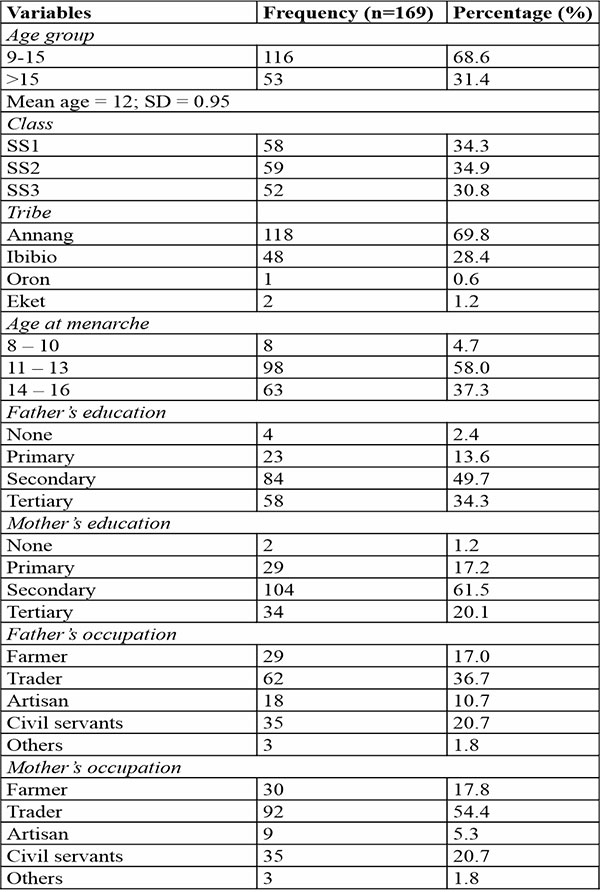
Awareness and knowledge of menstruation and menstrual hygiene
Most of the respondents (79.9%) were aware of menstruation before menarche. Mothers were the primary source of information for 42.6% of the participants. Regarding their understanding of menstruation, 41.4% described it as a sign of fertility, while 14.2% believed it was for cleansing the womb. More than half of the participants (58.0%) correctly identified the uterus as the source of menstrual blood. The expected age at menarche was predominantly between 10-12 years (50.9%). Furthermore, 62.1% of the participants had been informed about the menstrual duration, with the majority (72.8%) expecting a normal cycle length of 3-7 days. For menopause, 46.2% expected it to occur between 45-55 years, while 43.1% expected it to occur between 65-75 years (Table 2).
Table 2: Awareness and knowledge of menstruation among respondents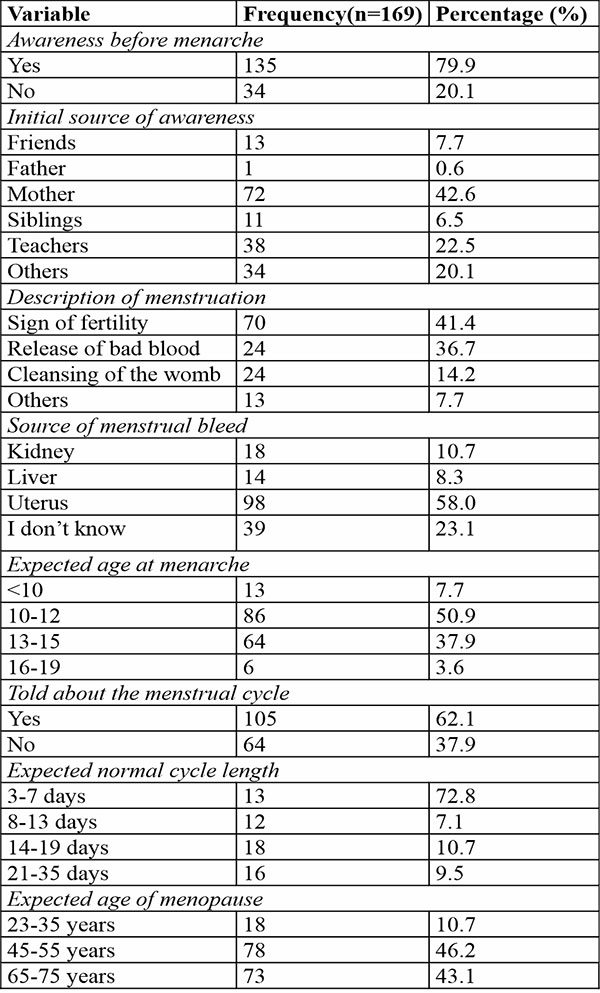
Sanitary pads were the most recognized menstrual hygiene products (73.4%). The primary sources of awareness included mothers (62.1%), teachers (20.1%), and friends (11.2%). Most participants (88.2%) considered sanitary pads the best menstrual hygiene product, while other options like toilet rolls (7.0%), reused cloths (3.0%), and tampons (1.8%) were less favoured (Table 3).
Table 3: Awareness of menstrual hygiene products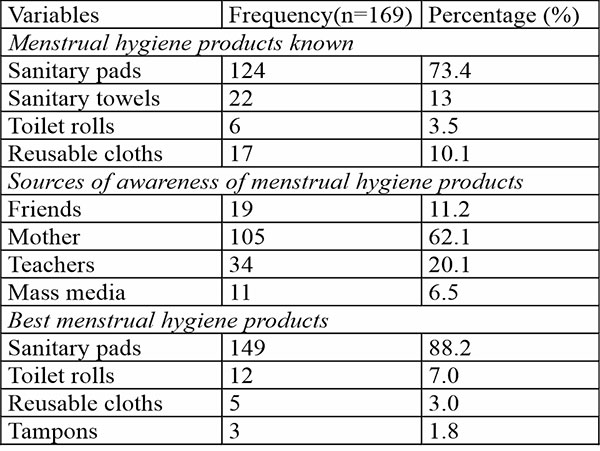
On proper menstrual hygiene management, the commonest response was bathing at least twice a day (32.6%) and cleaning private parts regularly (18.9%). ( Figure 1)
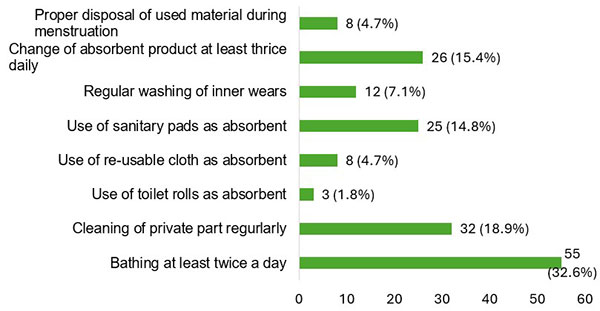
Figure 1: Knowledge of menstrual hygiene management
Practice of menstrual hygiene
The majority of respondents frequently used sanitary pads as their menstrual hygiene product, with 67.5% using sanitary pads during their last menstruation and 69.2% changed their absorbents three times per day. Additionally, 57.4% of the respondents used reusable cloth as their absorbent, and 45.6% disposed of menstrual hygiene products in pit latrines. (Table 4)
Table 4: Menstrual hygiene practice among respondents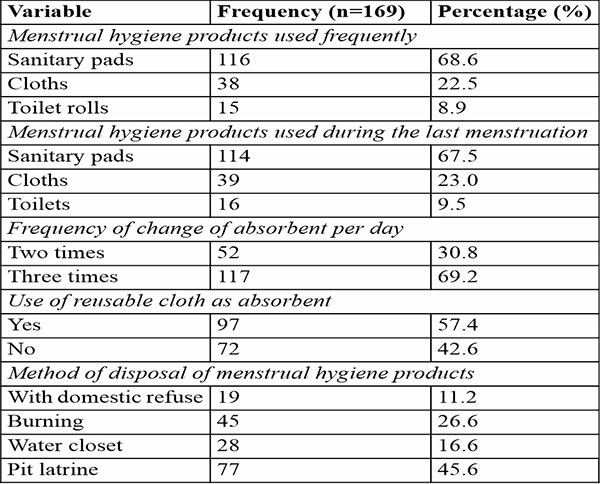
Health problems associated with menstrual hygiene practices
Majority of the respondents, 60.4% had abnormal vaginal discharge, 46.1% had milky discharge and 54.1% had genital itching during every menses (Table 5).
Table 5: Health problems associated with menstrual hygiene practices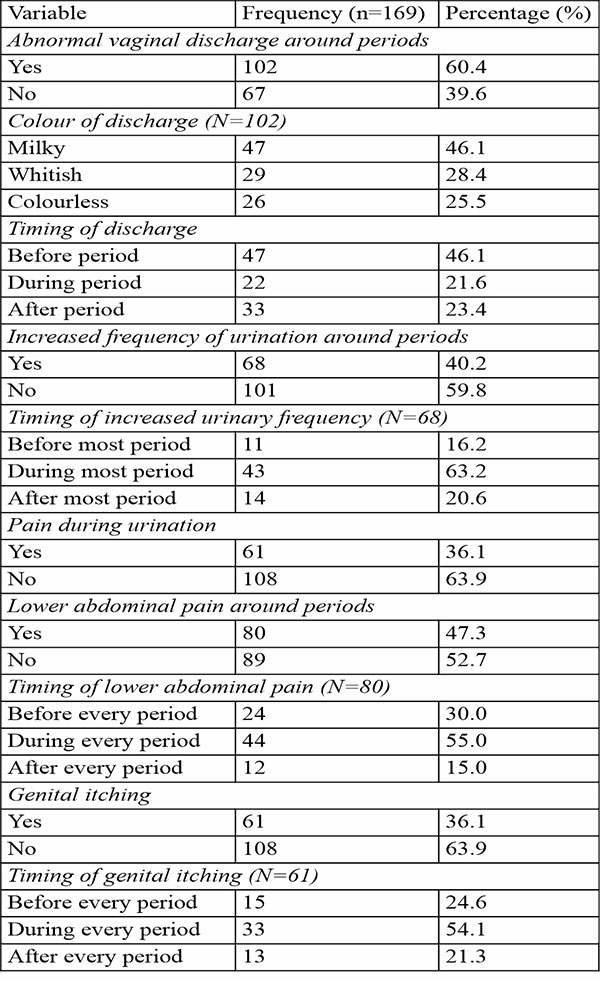
There was a significant association between the type of menstrual hygiene product used and the presence of lower urinary tract symptoms (p<0.0001) (Table 6).
Table 6: Association between type of menstrual hygiene product used and lower urinary tract symptoms
Discussion
This study aimed to evaluate menstrual hygiene awareness, practices, and associated health problems among adolescent females in a secondary school in Ukpom Abak. The mean age of the participants was 12 years, indicating a predominantly adolescent cohort. The majority experienced menarche between 11 and 13 years, consistent with a study from Calabar, which reported similar age ranges.3
Awareness of menstruation before menarche was high among respondents, with mothers being the primary source of information. This finding aligns with similar studies,9 emphasizing the importance of maternal education and willingness to discuss this topic in the menstrual health of adolescent girls. However, misconceptions about menstruation, such as viewing it as a release of bad blood or cleansing of the womb, indicate gaps in knowledge. The correct identification of the uterus as the source of menstrual blood by most respondents suggests a basic understanding, but those who were unaware of this highlight the need for comprehensive menstrual health education in schools.
Adequate and suitable sanitary materials could empower women and girls to feel more confident and comfortable with their bodies.9,17 Sanitary pads were the most recognized and preferred menstrual hygiene products, but the mixed-use of reusable cloths and sanitary pads may suggest economic constraints and varying levels of access to menstrual products. The practice of changing absorbents three times per day is commendable. However, more than half of the girls used reusable cloths, which emphasizes the need for affordable menstrual hygiene products and education on how to properly care for reusable products if unavoidable. In addition, the fact that 16% of the girls used the water closet to dispose of their used menstrual products reflects the lack of adequate disposal facilities or a lack of knowledge on proper disposal among these girls.
Some health problems were reported such as abnormal vaginal discharge and genital itching, with respondents using reusable cloths having a higher proportion of these symptoms. These findings align with studies indicating a higher prevalence of infections among users of reusable menstrual materials.11,17 The significant association between the type of menstrual hygiene product used and the presence of lower urinary tract symptoms highlights the health risks associated with inadequate menstrual hygiene practices. Where use of reusable materials such as napkins and towels are unavoidable, properly washing them with soap and water, and drying them in the sunlight after each use are key to ridding them of harmful bacteria. However, privacy issues and taboos associated with menstruation could prevent these practices, predisposing the user to infections. This was also seen in rural areas in India, where lack of water and hygiene materials like soap also featured as a barrier to properly caring for reusable materials.17
The study's findings point out the need for targeted interventions to improve menstrual health education and access to affordable menstrual hygiene products. Policies should focus on providing comprehensive menstrual health education in schools, involving both teachers and parents, particularly mothers, in educating girls about menstruation. Public health initiatives should aim to make affordable menstrual hygiene products widely available to reduce the reliance on reusable cloths and associated health risks. Additionally, improving menstrual waste disposal facilities in schools and communities is crucial to ensure safe and hygienic management of menstrual waste.
Conclusion
This study reveals gaps in menstrual hygiene knowledge and practices among adolescent girls in Ukpom Abak, Nigeria. Addressing these gaps requires a multifaceted approach involving education, resource provision, and improved waste management systems. By implementing comprehensive menstrual health education and ensuring access to affordable menstrual hygiene products, we can significantly improve the menstrual health and overall well-being of adolescent girls in this region.
Limitations of the study
The reliance on self-reported data through questionnaires introduces the potential for recall bias and social desirability bias, where respondents might provide socially acceptable answers rather than their true practices and experiences. Cultural and social norms may have influenced respondents' willingness to disclose certain information, potentially leading to underreporting. Lastly, the study relied on self-reported symptoms for health problems without clinical verification, which may affect accuracy. These limitations highlight the need for further research with more comprehensive data collection methods to better understand and address the challenges of menstrual hygiene management among adolescent girls.
Conflict of Interest: The authors declare no conflict of interest.
References
- UNICEF. The State of the World’s Children 2011: Adolescence - An age of opportunity [Internet]. UNICEF DATA. 2011 [cited 2024 Jul 7]. Available from: https://data.unicef.org/resources/the-state-of-the-worlds-children-2011-adolescents-an-age-of-opportunity/
- Anikwe CC, Mamah JE, Okorochukwu BC, Nnadozie UU, Obarezi CH, Ekwedigwe KC. Age at menarche, menstrual characteristics, and its associated morbidities among secondary school students in Abakaliki, southeast Nigeria. Heliyon. 2020 May 26;6(5):e04018.
- Eyong ME, Ntia HU, Ikobah JM, Eyong EM, Uket H, Enyuma C, et al. Pattern of pubertal changes in Calabar, South South Nigeria. Pan Afr Med J. 2018;31:20.
- Lacroix AE, Gondal H, Shumway KR, Langaker MD. Physiology, Menarche. In: StatPearls [Internet]. Treasure Island (FL): StatPearls Publishing; 2024 [cited 2024 Jul 7]. Available from: http://www.ncbi.nlm.nih.gov/books/NBK470216/
- Budhathoki SS, Bhattachan M, Castro-Sánchez E, Sagtani RA, Rayamajhi RB, Rai P, et al. Menstrual hygiene management among women and adolescent girls in the aftermath of the earthquake in Nepal. BMC Women’s Health. 2018 Feb 2;18(1):33.
- Eijk AM van, Sivakami M, Thakkar MB, Bauman A, Laserson KF, Coates S, et al. Menstrual hygiene management among adolescent girls in India: a systematic review and meta-analysis. BMJ Open. 2016 Mar 1;6(3):e010290.
- McMahon SA, Winch PJ, Caruso BA, Obure AF, Ogutu EA, Ochari IA, et al. “The girl with her period is the one to hang her head” Reflections on menstrual management among schoolgirls in rural Kenya. BMC International Health and Human Rights. 2011 Jun 16;11(1):7.
- An Assessment Of Menstrual Hygiene Management in Secondary Schools [Internet]. UNICEF; 2015 [cited 2024 Jul 9]. Available from: https://www.unicef.org/nigeria/media/1256/file/Assessment-menstrual-hygiene-management-in-secondary-schools-2.jpg.pdf
- Mohammed S, Larsen-Reindorf RE. Menstrual knowledge, sociocultural restrictions, and barriers to menstrual hygiene management in Ghana: Evidence from a multi-method survey among adolescent schoolgirls and schoolboys. PLoS One. 2020 Oct 22;15(10):e0241106.
- Fehintola FO, Fehintola AO, Aremu AO, Idowu A, Ogunlaja OA, Ogunlaja IP. Assessment of knowledge, attitude and practice about menstruation and menstrual hygiene among secondary high school girls in Ogbomoso, Oyo state, Nigeria. International Journal of Reproduction, Contraception, Obstetrics and Gynecology. 2017 Apr 27;6(5):1726–32.
- Torondel B, Sinha S, Mohanty JR, Swain T, Sahoo P, Panda B, et al. Association between unhygienic menstrual management practices and prevalence of lower reproductive tract infections: a hospital-based cross-sectional study in Odisha, India. BMC Infectious Diseases. 2018 Sep 21;18(1):473.
- Anand E, Singh J, Unisa S. Menstrual hygiene practices and its association with reproductive tract infections and abnormal vaginal discharge among women in India. Sexual & Reproductive Healthcare. 2015 Dec 1;6(4):249–54.
- Chakrabarty M, Singh A. Assessing the link between hygienic material use during menstruation and self-reported reproductive tract infections among women in India: a propensity score matching approach. PeerJ. 2023 Nov 17;11:e16430.
- Citypopulation. Nigeria: Administrative Division (States and Local Government Areas) - Population Statistics, Charts and Map [Internet]. 2022 [cited 2024 Jul 7]. Available from: https://www.citypopulation.de/en/nigeria/admin/
- Charan J, Biswas T. How to Calculate Sample Size for Different Study Designs in Medical Research? Indian J Psychol Med. 2013;35(2):121–6.
- Lawan UM, Yusuf NW, Musa AB. Menstruation and menstrual hygiene amongst adolescent school girls in Kano, Northwestern Nigeria. African Journal of Reproductive Health. 2010 Sep;14(3):201–7.
- Vishwakarma D, Puri P, Sharma SK. Interlinking menstrual hygiene with Women’s empowerment and reproductive tract infections: Evidence from India. Clinical Epidemiology and Global Health. 2021 Apr 1;10:100668.